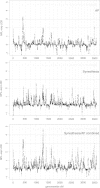Absolute pitch exhibits phenotypic and genetic overlap with synesthesia
- PMID: 23406871
- PMCID: PMC4707203
- DOI: 10.1093/hmg/ddt059
Absolute pitch exhibits phenotypic and genetic overlap with synesthesia
Abstract
Absolute pitch (AP) and synesthesia are two uncommon cognitive traits that reflect increased neuronal connectivity and have been anecdotally reported to occur together in an individual. Here we systematically evaluate the occurrence of synesthesia in a population of 768 subjects with documented AP. Out of these 768 subjects, 151 (20.1%) reported synesthesia, most commonly with color. These self-reports of synesthesia were validated in a subset of 21 study subjects, using an established methodology. We further carried out combined linkage analysis of 53 multiplex families with AP and 36 multiplex families with synesthesia. We observed a peak NPL LOD = 4.68 on chromosome 6q, as well as evidence of linkage on chromosome 2, using a dominant model. These data establish the close phenotypic and genetic relationship between AP and synesthesia. The chromosome 6 linkage region contains 73 genes; several leading candidate genes involved in neurodevelopment were investigated by exon resequencing. However, further studies will be required to definitively establish the identity of the causative gene(s) in the region.
Figures



Similar articles
-
A whole-genome scan and fine-mapping linkage study of auditory-visual synesthesia reveals evidence of linkage to chromosomes 2q24, 5q33, 6p12, and 12p12.Am J Hum Genet. 2009 Feb;84(2):279-85. doi: 10.1016/j.ajhg.2009.01.012. Epub 2009 Feb 5. Am J Hum Genet. 2009. PMID: 19200526 Free PMC article.
-
Absolute pitch is not necessary for pitch class-color synesthesia.Conscious Cogn. 2018 Oct;65:169-181. doi: 10.1016/j.concog.2018.08.010. Epub 2018 Sep 5. Conscious Cogn. 2018. PMID: 30195144
-
Rare variants in axonogenesis genes connect three families with sound-color synesthesia.Proc Natl Acad Sci U S A. 2018 Mar 20;115(12):3168-3173. doi: 10.1073/pnas.1715492115. Epub 2018 Mar 5. Proc Natl Acad Sci U S A. 2018. PMID: 29507195 Free PMC article.
-
Multicenter linkage study of schizophrenia candidate regions on chromosomes 5q, 6q, 10p, and 13q: schizophrenia linkage collaborative group III.Am J Hum Genet. 2000 Sep;67(3):652-63. doi: 10.1086/303041. Epub 2000 Aug 2. Am J Hum Genet. 2000. PMID: 10924404 Free PMC article.
-
Neurophysiology of synesthesia.Curr Psychiatry Rep. 2007 Jun;9(3):193-9. doi: 10.1007/s11920-007-0018-6. Curr Psychiatry Rep. 2007. PMID: 17521514 Review.
Cited by
-
Defining the biological bases of individual differences in musicality.Philos Trans R Soc Lond B Biol Sci. 2015 Mar 19;370(1664):20140092. doi: 10.1098/rstb.2014.0092. Philos Trans R Soc Lond B Biol Sci. 2015. PMID: 25646515 Free PMC article. Review.
-
One- or two-step? New insights into two-step hypothesis and rainbow-like theory for pitch class-color synesthesia.Front Psychol. 2025 Jan 10;15:1482714. doi: 10.3389/fpsyg.2024.1482714. eCollection 2024. Front Psychol. 2025. PMID: 39868013 Free PMC article.
-
Conceptual coherence but methodological mayhem: A systematic review of absolute pitch phenotyping.Behav Res Methods. 2025 Jan 21;57(2):61. doi: 10.3758/s13428-024-02577-z. Behav Res Methods. 2025. PMID: 39838215 Free PMC article.
-
Convergent evidence for the molecular basis of musical traits.Sci Rep. 2016 Dec 22;6:39707. doi: 10.1038/srep39707. Sci Rep. 2016. PMID: 28004803 Free PMC article. Review.
-
A Tendency Towards Details? Inconsistent Results on Auditory and Visual Local-To-Global Processing in Absolute Pitch Musicians.Front Psychol. 2019 Jan 22;10:31. doi: 10.3389/fpsyg.2019.00031. eCollection 2019. Front Psychol. 2019. PMID: 30723441 Free PMC article.
References
-
- Ward W.D., Burns E.M. In: The Psychology of Music. Deutsch D., editor. Orlando, FL: Academic Press, Inc.; 1982. pp. 431–451. Absolute pitch.
-
- Ross D.A., Olson I.R., Marks L.E., Gore J.C. A nonmusical paradigm for identifying absolute pitch possessors. J. Acoust. Soc. Am. 2004;116:1793–1799. - PubMed
-
- Gregersen P.K., Kowalsky E., Kohn N., Marvin E.W. Early childhood music education and predisposition to absolute pitch: teasing apart genes and environment. Am. J. Med. Genet. 2001;98:280–282. - PubMed
Publication types
MeSH terms
Grants and funding
LinkOut - more resources
Full Text Sources
Other Literature Sources

